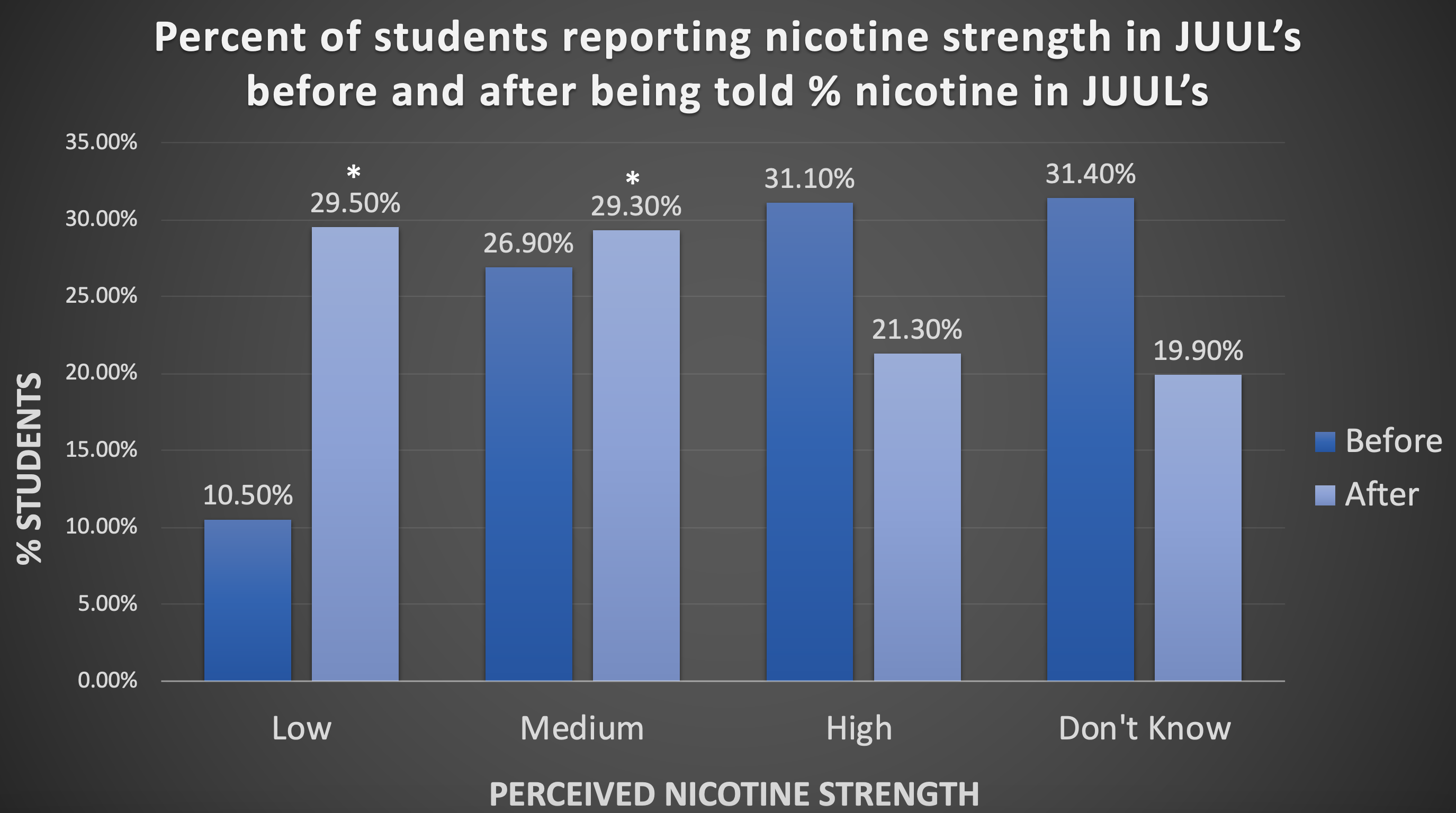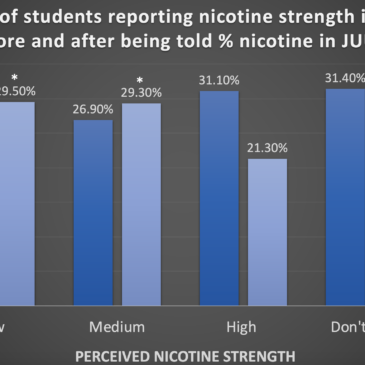JUUL e-cigarette use has been on the rise recently, with 9.5% of teenagers ages 15-17 and 11.2% of young adults ages 18-21 reporting JUUL use at some point throughout their lifetime. In fact, e-cigarette use among teenagers is now more common than cigarette use. Despite the fact that JUUL use is so common, many teenagers are not aware that nicotine is inside their JUUL, let alone how strong the nicotine is. This week, ASHES reviews an article by Meghan Morean and her colleagues looking at teenagers’ beliefs regarding the strength of nicotine in JUULs, before and after learning information about the actual nicotine content of JUULs.
What was the research question?
What are teenagers’ perceptions of the nicotine strength in JUULs before and after learning its actual nicotine content, and do these perceptions differ by JUUL-use status?
What did the researchers do?
The researchers surveyed 3,170 students from four high schools in Connecticut. Students reported their past-30-day and lifetime JUUL use. Participants rated the strength of nicotine in JUUL pods (low, medium, high, or I don’t know) before and after learning that the actual concentration of nicotine in JUULs is 5%. (Participants weren’t told that 5% is a substantially higher nicotine content compared to other tobacco products.) Participants also indicated whether they believed JUULs are e-cigarettes. The researchers categorized students by JUUL use status (past-30 day, ever users, never users). They used a generalized estimating equation model to look how participants’ beliefs changed and whether any changes were related to JUUL-use status.
What did they find?
Before having any information about the actual nicotine content in JUULs, 37.4% of students believed that the nicotine content was low or medium and 31.4% reported they were not sure how strong the nicotine content was (see figure). When students were told that the actual nicotine content in JUULs is 5%, the percent of students who believed the nicotine content in JUULs was low or medium increased to 58.8%. All students, regardless of JUUL-use status, were significantly more likely to rate the nicotine content as low or medium, rather than high, after receiving the information. However, this effect was bigger for those who had never used JUULs before. Additionally, only 61.1% of students believed that JUULs were e-cigarettes (15.3% did not think they were and the other 23.7% did not know). Participants who used JUULs ever, or used them in the last month, were more likely to report that JUULs were e-cigarettes compared to never users.

Figure. The percentage of individuals reporting nicotine strength in JUULs as low, medium, high or “I don’t know” before and after being told that the actual nicotine content in JUULs is 5%. * Indicates responses that were significantly different from “High” after information about nicotine content was given. Adapted from Morean et al. (2019). Click image to enlarge.
Why do these findings matter?
These results demonstrate a lack of knowledge, among both users and non-users, about the nicotine content in JUULs. If teenagers are under the impression that the nicotine content in JUULs is low, they may not be concerned about trying JUULs or eventually becoming a frequent user. Interventions can build off of this knowledge and focus on informing teenagers of the actual nicotine content in JUULs. In addition, interventions should make sure to demonstrate that 5% nicotine is actually high nicotine content, potentially by comparing this figure to the nicotine content of cigarettes and other e-cigarettes. Spreading this information would hopefully prevent teenagers from using JUULs due to misconceptions about their safety.
Every study has limitations. What are the limitations of this study?
Though the students in this study were told that JUULs contained 5% nicotine, the JUUL packaging at the time stated that JUULs were “5% strength.” Therefore, many users may not have understood that this percentage corresponded to nicotine content even if they had seen this information on the label. Additionally, students were given four options to rate the strength of nicotine, but it is difficult to know whether all students had the same perceptions of low, medium and high nicotine strength. Future research could test students’ perceptions of nicotine strength using comparisons to other nicotine products, such as cigarettes.
For more information:
SmokeFree offers tools and tips for quitting and maintaining abstinence from smoking tobacco. The Centers for Disease Control and Prevention offers information, tips, and tools about e-cigarettes and how to quit. For self-help tools, please visit The BASIS Addiction Resources page.
— Alessandra Grossman
What do you think? Please use the comment link below to provide feedback on this article.





Ken Winters May 5, 2020
Thank you for this post. This study brings to mind how teenagers perceive THC levels in cannabis products.